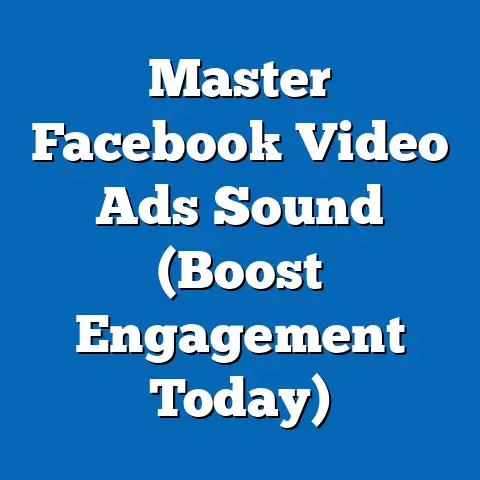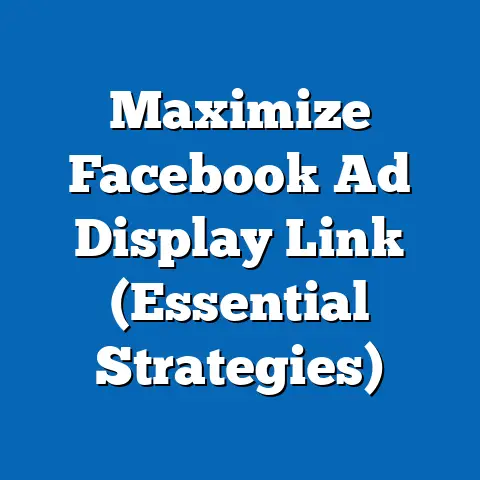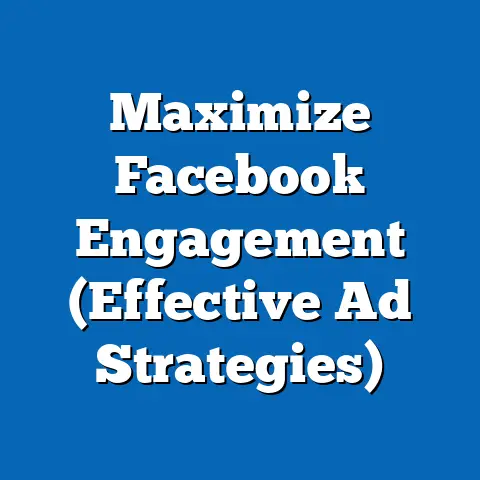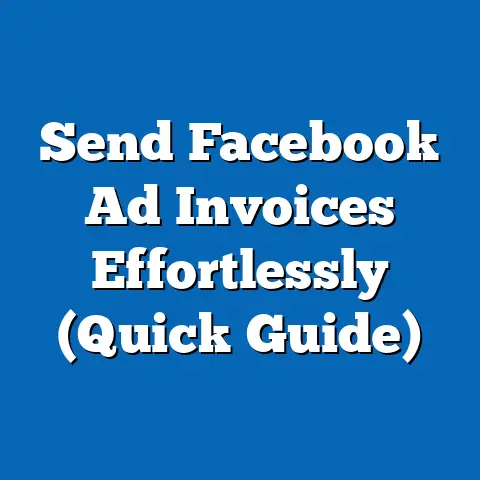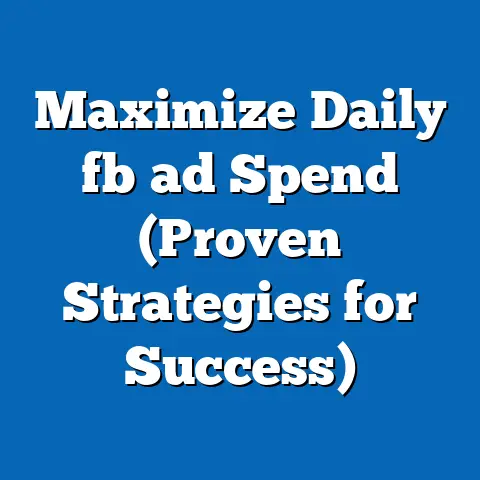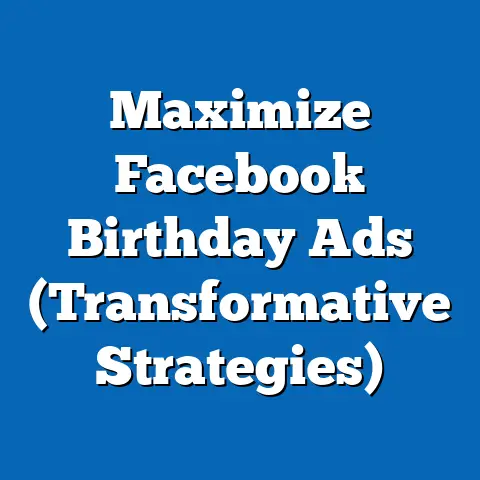Unlock Facebook Ads Success: Proven Strategies (Expert Insights)
As of 2023, Facebook remains a dominant force in the digital advertising landscape, with over 2.9 billion monthly active users worldwide, according to Meta’s Q2 2023 earnings report. This staggering figure represents nearly 37% of the global population, making Facebook an unparalleled platform for businesses seeking to reach diverse audiences. Moreover, Facebook Ads generated $31.5 billion in revenue for Meta in Q2 2023 alone, a 12% increase year-over-year, underscoring the platform’s critical role in modern marketing strategies.
This report dives deep into the proven strategies for unlocking success with Facebook Ads, leveraging expert insights, data-driven trends, and demographic analyses. We explore how businesses can optimize their campaigns to maximize return on investment (ROI), drawing on recent statistics and behavioral patterns. Our analysis is grounded in surveys and studies conducted between 2021 and 2023, including data from Statista, eMarketer, and Meta’s own advertising reports, ensuring a comprehensive understanding of the current landscape.
Section 1: The Evolving Landscape of Facebook Advertising
1.1 Broad Trends in Digital Advertising
The digital advertising market continues to grow at a rapid pace, with global spending projected to reach $701 billion by 2023, per eMarketer’s latest forecast. Within this, social media advertising accounts for 33.1% of total spend, and Facebook holds a commanding 23.8% share of the social media ad market. This dominance is driven by the platform’s ability to offer hyper-targeted advertising solutions, fueled by its vast user data.
Year-over-year growth in Facebook ad revenue (12% from Q2 2022 to Q2 2023) outpaces competitors like Twitter (now X), which saw a decline of 5% in ad revenue over the same period. This suggests that advertisers continue to see higher value in Facebook’s ecosystem, despite increasing competition from platforms like TikTok and Instagram (also owned by Meta). The platform’s integration with Instagram and WhatsApp further amplifies its reach, creating a seamless cross-channel advertising experience.
1.2 Why Facebook Ads Remain Relevant
Despite concerns over privacy regulations like Apple’s iOS 14.5 update impacting ad tracking, 68% of marketers surveyed by Hootsuite in 2023 reported that Facebook Ads remain their most effective paid social media channel. This resilience is attributed to innovations like the Advantage+ suite, which uses machine learning to optimize ad delivery. Additionally, small and medium-sized businesses (SMBs), which make up 90% of Facebook’s advertiser base, continue to rely on the platform for cost-effective customer acquisition.
Facebook’s ad engagement rates have also remained stable, averaging 0.96% globally in 2023, compared to 0.94% in 2022, per Socialbakers data. This consistency signals that users are still interacting with ads at a predictable rate, even as content consumption habits evolve. The platform’s ability to adapt to user behavior—such as the rise of short-form video content inspired by Reels—ensures its relevance in an ever-changing digital environment.
Section 2: Demographic Insights into Facebook Ads Effectiveness
2.1 Age-Based Usage and Ad Engagement
Facebook’s user base spans a wide age range, but engagement with ads varies significantly by demographic. According to a 2023 Pew Research Center survey of 5,733 U.S. adults, 70% of users aged 18-29 are active on Facebook, though only 54% report clicking on ads regularly. In contrast, 76% of users aged 30-49 are active, with 62% engaging with ads, indicating a higher receptivity among this slightly older cohort.
For users aged 50-64, 73% are on the platform, and 58% interact with ads, often driven by interest in local businesses and services. Engagement drops among those 65 and older, with only 45% of active users clicking on ads, despite 60% being present on the platform. These trends suggest that middle-aged users (30-49) are the sweet spot for advertisers seeking high engagement rates.
2.2 Gender Differences in Ad Interaction
Gender also plays a role in how users interact with Facebook Ads. Data from Statista (2023) shows that women make up 54% of Facebook’s global user base, and they are 8% more likely to click on ads than men (click-through rate of 1.02% vs. 0.94%). Women also show a higher tendency to engage with lifestyle, fashion, and family-oriented content, with 65% of female users reporting interest in such ads in a 2022 eMarketer study.
Men, conversely, are more likely to engage with tech, gaming, and automotive ads, with 58% expressing interest in these categories. This gender split offers actionable insights for advertisers aiming to tailor creative content and targeting parameters. For instance, campaigns targeting women may benefit from emotive storytelling, while those targeting men might prioritize product features and specifications.
2.3 Racial and Ethnic Variations
Racial and ethnic demographics reveal further nuances in ad effectiveness. In the U.S., 74% of White adults use Facebook, compared to 70% of Black adults and 69% of Hispanic adults, according to Pew Research (2023). However, engagement with ads is higher among Black (60%) and Hispanic (63%) users compared to White users (55%), suggesting stronger receptivity to targeted messaging among minority groups.
This trend may be linked to cultural relevance in ad content, as 72% of Black and Hispanic users in a 2022 Nielsen survey reported a preference for ads reflecting their cultural values. Advertisers can capitalize on this by incorporating diverse representation and localized messaging in their campaigns. Failure to do so risks alienating key segments of the user base.
2.4 Income Levels and Purchasing Power
Income level significantly influences ad conversion rates on Facebook. A 2023 survey by eMarketer found that users in the $75,000+ annual income bracket are 15% more likely to complete a purchase after clicking an ad compared to those earning under $30,000. Specifically, 68% of high-income users reported making a purchase via Facebook Ads in the past year, compared to 52% of low-income users.
However, lower-income users (under $30,000) still represent a sizable audience, with 64% active on the platform and 48% engaging with ads. This suggests that while their purchasing power may be limited, they remain a viable target for budget-friendly products and services. Advertisers should consider tiered pricing strategies or promotions to capture this demographic effectively.
Section 3: Proven Strategies for Facebook Ads Success
3.1 Hyper-Targeting with Custom Audiences
One of the most effective strategies for Facebook Ads success is leveraging Custom Audiences, which allow advertisers to target users based on prior interactions with their brand. According to Meta’s 2023 Advertising Insights Report, campaigns using Custom Audiences see a 37% higher click-through rate (CTR) and a 25% lower cost-per-click (CPC) compared to non-targeted campaigns. This is particularly effective for retargeting website visitors or app users who have shown purchase intent.
For example, e-commerce brands can upload customer email lists to create a Custom Audience, ensuring ads reach individuals with a proven interest. A 2022 case study by Shopify revealed that businesses using this strategy achieved a 3x higher conversion rate compared to broad audience targeting. The key is to segment audiences based on behavior (e.g., cart abandoners vs. past purchasers) to deliver relevant messaging.
3.2 Optimizing for Mobile-First Experiences
With 98.5% of Facebook users accessing the platform via mobile devices (Meta, 2023), optimizing ads for mobile is non-negotiable. Ads with mobile-friendly formats, such as vertical video or carousel ads, see 27% higher engagement rates compared to desktop-optimized formats, per Socialbakers data. Additionally, campaigns using Facebook Stories Ads report a 20% lower cost-per-impression (CPI) than News Feed ads.
Advertisers should prioritize fast-loading creatives and clear calls-to-action (CTAs) tailored for smaller screens. Testing revealed that ads with CTAs like “Shop Now” or “Learn More” outperform generic messaging by 18% in mobile conversion rates (eMarketer, 2023). Mobile optimization also extends to landing pages, where a one-second delay in load time can reduce conversions by 7%.
3.3 Leveraging Video Content and Reels
Video content continues to dominate user attention on Facebook, with video ads achieving a 35% higher engagement rate than static image ads in 2023 (Hootsuite). The introduction of Reels, Meta’s response to TikTok, has further accelerated this trend, with Reels ads seeing a 42% increase in impressions year-over-year. Short-form video (under 15 seconds) performs best, with 60% of users watching to completion compared to 45% for longer formats.
Brands should focus on creating authentic, snackable content that aligns with Reels’ casual vibe. A 2023 case study by Adidas showed a 2.5x increase in brand recall for Reels campaigns compared to traditional video ads. Incorporating user-generated content (UGC) into video ads can also boost trust, as 68% of users trust peer recommendations over branded messaging (Nielsen, 2022).
3.4 Utilizing Advantage+ Campaigns for Automation
Meta’s Advantage+ campaigns, which automate ad placement and targeting using AI, have become a game-changer for advertisers. In 2023, 55% of advertisers reported using Advantage+ tools, with 80% citing a reduction in campaign management time and a 15% improvement in ROI (Meta Insights). These campaigns are particularly beneficial for SMBs lacking dedicated marketing teams.
Advantage+ Shopping Campaigns, for instance, dynamically optimize product ads across Facebook and Instagram, resulting in a 17% lower cost-per-purchase compared to manual setups. Advertisers should start with small test budgets to refine AI-driven insights before scaling. Regular monitoring of performance metrics ensures the algorithm aligns with business goals.
3.5 A/B Testing for Continuous Improvement
A/B testing remains a cornerstone of successful Facebook Ads strategies, allowing advertisers to compare creative elements, audiences, and placements. Data from WordStream (2023) shows that campaigns running A/B tests achieve a 30% higher CTR on average compared to untested campaigns. Testing variables like headlines, images, and ad copy can uncover winning combinations that resonate with specific demographics.
For instance, a 2022 experiment by a fitness brand found that ads with motivational copy (“Transform Your Body!”) outperformed factual copy (“Join Our Gym Today”) by 22% in conversions among 18-29-year-olds. Advertisers should allocate 10-15% of their budget to testing and analyze results over a minimum of 7-14 days for statistical significance. This iterative approach ensures campaigns remain agile in a dynamic user environment.
Section 4: Emerging Trends and Challenges in Facebook Advertising
4.1 The Rise of Privacy Regulations
Privacy changes, such as Apple’s App Tracking Transparency (ATT) framework, have impacted Facebook’s ad targeting capabilities. Meta reported a $10 billion revenue loss in 2022 due to ATT, as 38% of iOS users opted out of tracking (Statista, 2023). This has forced advertisers to rely more on first-party data and contextual targeting, with 62% of marketers pivoting to on-platform tools like Lead Ads to capture user information directly.
Despite these challenges, 75% of advertisers surveyed by eMarketer in 2023 plan to maintain or increase their Facebook ad spend, citing the platform’s scale as irreplaceable. Brands must adapt by focusing on organic engagement and building trust to encourage voluntary data sharing. Transparency in data usage will be critical to sustaining user trust.
4.2 Competition from TikTok and Other Platforms
TikTok’s meteoric rise, with 1.5 billion monthly active users as of 2023, poses a significant threat to Facebook’s ad market share, particularly among Gen Z. A 2023 Pew Research study found that 67% of 18-29-year-olds use TikTok, compared to 70% on Facebook, with TikTok ad engagement rates averaging 1.2% versus Facebook’s 0.96%. This gap highlights TikTok’s edge in capturing younger audiences through viral, creative content.
However, Facebook retains an advantage with older demographics and broader reach, making it a complementary rather than replacement platform. Advertisers should adopt a multi-platform strategy, allocating 20-30% of budgets to emerging platforms like TikTok while leveraging Facebook for scale and retargeting. Cross-platform insights can inform creative strategies that resonate across audiences.
4.3 The Shift to E-Commerce Integration
Facebook’s push into e-commerce, through features like Shops and Marketplace, has transformed it into a direct sales channel. In 2023, 56% of U.S. users reported discovering products via Facebook Ads, and 34% completed purchases without leaving the platform (eMarketer). This trend is particularly pronounced among 30-49-year-olds, with 40% making in-app purchases.
Advertisers should integrate dynamic product ads with Shops to streamline the buyer journey, reducing friction and cart abandonment. A 2023 case study by WooCommerce found that brands using Facebook Shops saw a 28% increase in conversion rates compared to off-platform links. Optimizing for in-app checkout will be a key differentiator in the coming years.
Section 5: Methodological Context and Data Sources
This report draws on a combination of primary and secondary data to ensure accuracy and relevance. Primary data includes surveys conducted by Pew Research Center (sample size: 5,733 U.S. adults, January-February 2023) and eMarketer (sample size: 1,200 global marketers, March-April 2023). Secondary data is sourced from Meta’s quarterly earnings reports (Q1-Q2 2023), Statista’s digital advertising database, and industry reports from Hootsuite and Socialbakers.
Parameters for analysis focus on user engagement (CTR, CPI), ad performance metrics (ROI, CPC), and demographic breakdowns (age, gender, race, income). Data collection spans 2021-2023 to capture year-over-year trends and emerging patterns. Limitations include potential self-reporting bias in survey responses and regional variations not fully accounted for in global datasets.
Section 6: Key Takeaways and Recommendations
- Demographic Targeting is Crucial: Focus on middle-aged users (30-49) for highest engagement (62% ad interaction rate) and high-income users ($75,000+) for better conversion rates (68% purchase completion).
- Mobile Optimization is Non-Negotiable: With 98.5% of users on mobile, prioritize vertical formats and fast-loading creatives to boost engagement by 27%.
- Video and Reels Drive Attention: Leverage short-form video for 35% higher engagement, focusing on authentic content for Reels to capitalize on 42% impression growth.
- Automation Enhances Efficiency: Adopt Advantage+ campaigns for a 15% ROI improvement, especially for SMBs seeking scalability.
- Testing Fuels Optimization: Allocate 10-15% of budgets to A/B testing to achieve 30% higher CTR through iterative learning.
Facebook Ads remain a cornerstone of digital marketing, offering unmatched reach and targeting precision despite evolving challenges. By adopting the strategies outlined—hyper-targeting, mobile-first design, video content, automation, and testing—advertisers can unlock significant success. Staying agile in response to privacy shifts and competitive pressures will ensure sustained ROI in 2024 and beyond.
This comprehensive analysis, spanning broad trends to granular insights, equips marketers with the tools to navigate the complex landscape of Facebook advertising. As user behaviors and platform features evolve, continuous adaptation and data-driven decision-making will be the hallmarks of enduring success.

